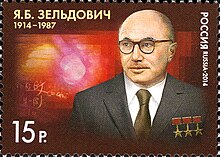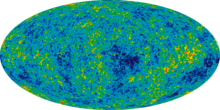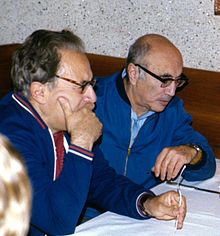Biography
Early life and education
Yakov Zeldovich was born into a Belarusian Jewish family in his grandfather's house in Minsk. However, in mid-1914, the Zeldovich family moved to Saint Petersburg. They resided there until August 1941, when the family was evacuated together with the faculty of the Institute of Chemical Physics to Kazan to avoid the Axis Invasion of the Soviet Union. : 301 They remained in Kazan until the summer of 1943, when Zeldovich moved to Moscow.
His father, Boris Naumovich Zeldovich, was a lawyer; his mother, Anna Petrovna Zeldovich (née Kiveliovich), a translator from French to Russian, was a member of the Writer's Union. Despite being born into a devoted and religious Jewish family, Zeldovich was an "absolute atheist".
Zeldovich was an autodidact. He was regarded as having a remarkably versatile intellect, and during his life he explored and made major contributions to a wide range of scientific endeavors. From a given opportunity in May 1931, he secured an appointment as a laboratory assistant at the Institute of Chemical Physics of the Academy of Sciences of the Soviet Union, and remained associated with the institute for the remainder of his life. : 301 As a laboratory assistant, he received preliminary instructions on the topics involved in the physical chemistry and built up his reputation among his seniors at the Institute of Chemical Physics. : 301
From 1932 to 1934, Zeldovich attended the undergraduate courses on physics and mathematics at the Leningrad State University (now Saint Petersburg State University), and later attended the technical lectures on introductory physics at the Leningrad Polytechnic Institute (now Peter the Great St. Petersburg Polytechnic University). : 301 : 2–5
In 1936, he was successful in his candidacy for the Candidate of Science degree (a Soviet equivalent of PhD), having successfully defended his dissertation on the topic of the "adsorption and catalysis on heterogeneous surfaces". : 301 The centrality of his thesis focused towards the research on the Freundlich (or classical) adsorption isotherm, and Zeldovich discovered the theoretical foundation of this empirical observation.
In 1939, Zeldovich prepared his dissertation based on the mathematical theory of the physical interpretation of nitrogen oxidation, and successfully received the Doctor of Sciences in mathematical physics when it was reviewed by Alexander Frumkin. : 39–40 Zeldovich discovered its mechanism, known in physical chemistry as the thermal NOx mechanism or Zeldovich mechanism.
Soviet program of nuclear weapons
Zeldovich is regarded as a secret principal of the Soviet nuclear weapons project; his travels abroad were highly restricted, to Eastern Europe, under close Soviet security. : 198–199 Soon after the discovery of nuclear fission (by German chemist Otto Hahn in 1939) Russian physicists had begun investigating the scope of nuclear-fission physics, and undertook seminars on that topic; Igor Kurchatov and Yulii Khariton were engaged in 1940. : 79–80
In May 1941, Zeldovich worked with Khariton in constructing a theory, on the kinetics of nuclear reactions in the presence of the critical conditions. : 81 The work of Khariton and Zeldovich was extended into theories of ignition, combustion and detonation; these accounted for features which had not previously been correctly predicted, observed, nor explained. : 82 The modern theory of detonation accordingly is called the Zeldovich-von Neumann-Dohring, or ZND, theory, and its development involved tedious fast neutron calculations; this work had been delayed, due to the German invasion of the Soviet Union, which obstructed progress on findings that in June 1941 would be de-classified. : 82 In 1942, Zeldovich was relocated to Kazan, and tasked by the People's Commissariat of Munitions to carry out work on conventional gun powders to be supplied to the Soviet Army, while Khariton was asked to design the new types of conventional weaponry. : 87–88
In 1943, Joseph Stalin decided to launch an arms build-up of nuclear weapons, under the charge of Igor Kurchatov; the latter requested Stalin to relocate Zeldovich and Khariton to Moscow, in the nuclear weapons program. : 87–88 Zeldovich joined Igor Kurchatov's small team at this secretive laboratory in Moscow to launch the work on the nuclear combustion theory, and became a head of the theoretical department at the Arzamas-16 in 1946.
With Isaak Gurevich, Isaak Pomeranchuk, and Khariton, Zeldovich prepared a scientific report on the feasibility of releasing energy through nuclear fusion triggered by an atomic explosion, and presented it to Igor Kurchatov. Zeldovich had benefitted from physical and technical knowledge provided by German physicist Klaus Fuchs and American physicist Theodore Hall, who each had worked on the American Manhattan Project to develop nuclear weapons. : 89–90
In 1949, Zeldovich led a team of physicists that conducted the first nuclear test, the RDS-1, based roughly on the American design obtained through the atomic spies in the United States, though he continued his fundamental work on explosive theory. : 89–90 Zeldovich then began working on modernizing the successive designs of the nuclear weapon and initially conceived the idea of hydrogen bomb to Andrei Sakharov and others. : 89–90 In the course of his work on nuclear weapons, Zeldovich did ground-breaking work in radiation hydrodynamics, and the physics of matter at high pressure.[citation needed]
Between 1950 and 1953, Zeldovich performed calculations necessary for the feasibility of the hydrogen bomb that were verified by Andrei Sakharov, although the two groups worked in parallel on the development of the thermonuclear fusion. However, it was Sakharov that radically changed the approach to thermonuclear fusion, aided by Vitaly Ginzburg in 1952. : 56–57 He remained associated with the nuclear testing program, while heading the experimental laboratories at Arzamas-16 until October 1963, when he left for academia. : 38–40


